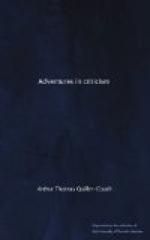The problem of the story is the commonest in fiction. And when I add that the injured husband has been married before and that his first wife, honestly supposed to be dead, returns to threaten his happiness, you will see that Mrs. Woods sets forth upon a path trodden by many hundreds of thousands of incompetent feet. To start with such a situation almost suggests bravado. If it be bravado, it is entirely justified as the tale proceeds: for amid the crowd of failures Mrs. Woods’s solution wears the singular distinction of truth. That the book is written in restrained and beautiful English goes without saying: but the best tribute one can pay to the writing of it is to say that its style and its truthfulness are at one. If complaint must be made, it is the vulgar complaint against truth—that it leaves one a trifle cold. A less perfect story might have aroused more emotion. Yet I for one would not barter the pages that tell of Joe Morris’s final surrender of his wife—with their justness of imagination and sobriety of speech—for any amount of pity and terror.
A word on the few merely descriptive passages in the book. Mrs. Woods’s scene-painting has all a Frenchman’s accomplishment with the addition of that open-air feeling and intimate knowledge of the phenomena of “out-of-doors” which a Frenchman seldom or never attains to. Though not, perhaps, her strongest gift, it is the one by which she stands most conspicuously above her contemporaries. The more credit, then, that she uses it so temperately.
FOOTNOTES:
[A] The Vagabonds. By Margaret L. Woods. London: Smith, Elder & Co.
MR. HALL CAINE
August 11, 1894. “The Manxman.”
Mr. Hall Caine’s new novel The Manxman (London: William Heinemann) is a big piece of work altogether. But, on finishing the tale, I turned back to the beginning and read the first 125 pages over again, and then came to a stop. I wish that portion of the book could be dealt with separately. It cannot: for it but sets the problem in human passion and conduct which the remaining 300 pages have to solve. Nevertheless the temptation is too much for me.
As one who thought he knew how good Mr. Hall Caine can be at his best, I must confess to a shock of delight, or rather a growing sense of delighted amazement, while reading those 125 pages. Yet the story is a very simple one—a story of two friends and a woman. The two friends are Philip Christian and Pete Quilliam: Philip talented, accomplished, ambitious, of good family, and eager to win back the social position which his father had lost by an imprudent marriage; Pete a nameless boy—the bastard son of Philip’s uncle and a gawky country-girl—ignorant, brave, simple-minded, and incurably generous. The boys have grown up together, and in love are almost more than brothers when the time comes for them to




